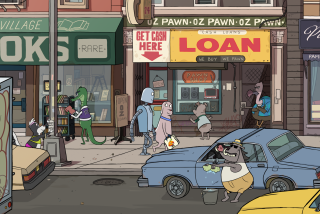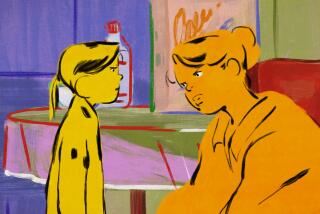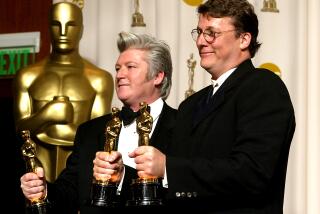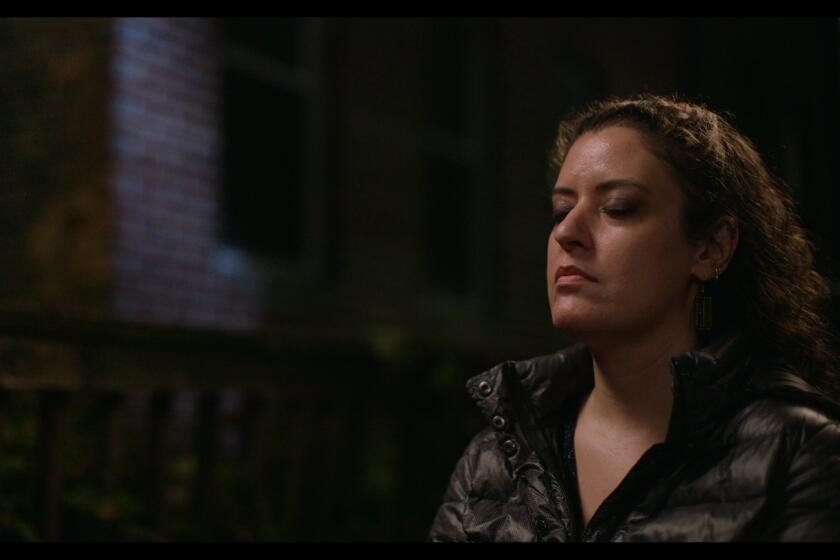Oscars 2014: Contender ‘Ernest and Celestine’ puts art back into animation
Oscar’s animated feature race is a clash of the major Hollywood studios this year, with Disney, Fox/DreamWorks and Universal/Illumination all contending. But one movie in the mix -- a French-Belgian production about the unlikely friendship between a mouse and a bear -- is the sort that is alien to the high-stakes U.S. animation industry.
Made with hand-painted watercolor backgrounds and a modest $12-million price tag, “Ernest & Celestine,” which U.S. distributor GKIDS will release in Los Angeles on Friday, is based on a whimsical series of children’s books by reclusive Brussels-born author Gabrielle Vincent.
In an era of shiny, perfect computer animation, the result is unusual -- a movie in which the brush strokes show.
OSCARS 2014: Full coverage | Top nominees
Championed by Didier Brunner, the godfather of France’s burgeoning animation industry and producer of the surrealist 2003 comedy “Triplets of Belleville,” “Ernest & Celestine” is the first feature from young French director Benjamin Renner.
Vincent penned the first “Ernest & Celestine” book in 1980 and, like many European children, Brunner’s daughter, Pauline, was delighted by the fanciful characters. (About 30 years later, Pauline voices Celestine in the French-language version of the movie.)
“She literally fell in love,” Brunner said through a translator. “This huge impressive bear who was also so tender and paternal and this little mouse with her incorrigible nibbling but who was still so adorable with her mischievousness and her strength. Two completely improbable friends who became inseparable accomplices.”
Brunner approached Vincent about the film rights in the 1980s, but the author, who felt she had been taken advantage of by another producer, declined to sell them. “She thought animation was very commercial, not an artistic technique,” Renner said last summer when he was in town for the L.A. Film Festival.
Vincent died in 2000 and, several years later, her Belgian publisher contacted Brunner to offer to sell the film rights. “I did not hesitate for a second and bought them all without any qualms,” Brunner said.
OSCAR WATCH 2014: Everything you need to know
He hired French novelist Daniel Pennac, who had been pen pals with Vincent, to craft her vignettes into a screenplay.
Wanting to avoid the look of corporate animated movies, Brunner sought a director in France’s art schools, among the world’s best for training animators (Many of the artists who worked on the Oscar-nominated “Despicable Me 2” for Paris- and L.A.-based Illumination Entertainment also came out of France’s art colleges.)
At La Poudriere, an art school in the south of France, Brunner saw “A Mouse’s Tale,” Renner’s student film about a mouse who talks a lion out of eating him.
“He was a young prodigy of animated drawing who, with little money and tons of talent, directed a 5-minute-long short film that was poetic, funny and introduced animated characters with vivacity and intelligence,” Brunner said. “The cherry on top was that he told me he was fascinated with small animals, such as rodents and mice.”
Renner, then 24, had grown up in the countryside outside Paris watching vintage Disney cartoons -- Donald Duck and the “Silly Symphonies” were favorites. But Renner told Brunner that he didn’t feel up to the task of directing a feature.
VIDEO: Animators roundtable: Full interview
“I said, ‘I’m just graduating,’ ” Renner said. “I don’t have the skill and I can’t assume the responsibility. I don’t know how to work with actors, with music, all those things. I wanted to make the best thing possible, but I did not feel like I was the person to make the best thing possible.”
Brunner had faith, but gave Renner some help -- two Belgian co-directors, Stéphane Aubier and Vincent Patar, who wrote and directed the 2009 stop-motion film “A Town Called Panic.” They came in to advise on the storyboards.
To preserve Vincent’s naturalistic style of illustration, Renner placed his computer-animated characters against hand-painted backgrounds of snow-covered, cobblestone streets and serpentine underground tunnels.
“This film, you can draw it,” Renner said. “You can see how it’s made. You can see the ink. In a Pixar movie, I need to study for five years before I can try to do something like this, because I need to know how to use computer, how to shade, how to do all those things.”
In the English-language version, Forest Whitaker voices Ernest and teenage actress Mackenzie Foy of the “Twilight” series is Celestine.
VIDEO: Animators talk influence of voice actors on their characters
Reviews for the film have been overwhelmingly positive since its 2012 premiere at Cannes. “Ernest & Celestine” has a 100% fresh rating on Rotten Tomatoes, with critics praising its artful animation and old-fashioned sweetness, though the movie hasn’t matched the box-office success of “Triplets of Belleville” abroad.
Brunner and Renner will attend the Oscars this weekend. The producer, who recently retired as head of the Paris-based animation company Les Armateurs, says he plans to make a series of “Ernest & Celestine” shorts for television.
Renner, now 30, is working on a short film about someone who gets swallowed by an ogre. He said he hasn’t yet been enticed by the American animation world.
“I really love working with my friends in France,” Renner said. “The fact that we have low budgets, it’s possible to take risks.”
More to Read
Only good movies
Get the Indie Focus newsletter, Mark Olsen's weekly guide to the world of cinema.
You may occasionally receive promotional content from the Los Angeles Times.











